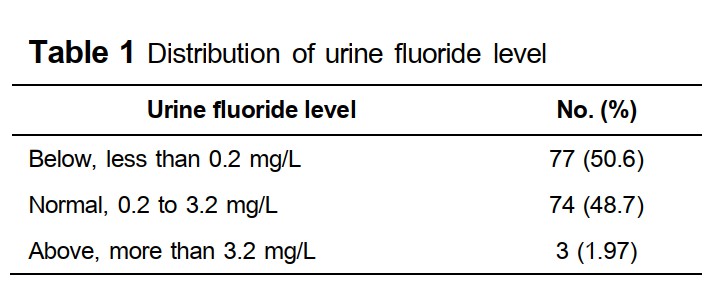Fluoride level in plasma blood and urine of first-trimester pregnant women living in a province
Keywords:
Fluoride, plasma blood, urine, pregnant womenAbstract
The study was aimed to determine the fluoride level in blood and urine of 154 first-trimester pregnant women among 7 public hospitals of a province. The concentration of plasma-blood fluoride was not determined in all subjects. For concentration of urine fluoride concentration, 77 cases (50.6%) had low fluoride level (less than 0.2 mg/L), 74 cases (48.7%) revealed the normal fluoride level (0.2 to 3.2 mg/L. Only 3 subjects (1.97) had high fluoride level (more than 3.2 mg/L).
References
2. Fawell J, Bailey K, Chilton J, Dahi E, Fewtrell L, Magara Y. Fluoride in Drinking Water. London: IWA Publishing; 2006.
3. DenBesten P, Li W. Chronic fluoride toxicity: Dental Fluorosis. Monogr Oral Sci. 2011;22:81-96.
4. Committee on Fluoride in Drinking Water, National Research Council, Measures of Exposure to Fluoride in the United States. Fluoride in drinking water. A scientific review of EPA’s standards. USA: The national Academic Press; 2006.
5. Driscoll WS. A review of clinical research on the use of prenatal fluoride administration for prevention of dental caries. ASDC J Dent Child. 1981;48:109-17.
6. Brambilla E, Felloni A, Gagliani M, Malerba A, Garcia-Godoy F, Strohmenger L. Caries prevention during pregnancy: Results of a 30-month study. Am Dent Assoc. 1998;129:1372-4.
7. Glenn FB, Glenn WD, Burdi AR. Prenatal fluoride for growth and development: Part X. J Dent Child 1997;5:317-21.
8. Vohra R, Velez LI, Rivera W, Rivera W, Benitez FL, Delaney KA. Recurrent lifethreatening ventricular dysrhythmia associated with acute hydrofluoric acid ingestion: Observations in one case and implications for mechanism of toxicity. Clin Toxicol (Phila). 2008;46(1):79-84.
9. Husdan H, Vogl R, Oreopoulos D, Gryfe C, Rapoport A. Serum ionic fluoride: normal range and relationship to age and sex. Clin Chem. 1976;22:1884–8.
10. Cowell DD, Taylor WH. Ionic fluoride: A study of its physiological variation in man. Ann Clin Biochem. 1981;18:76-83.
11. Ekstrand J, Ehrnebo M. The relationship between plasma fluoride, urinary excretion rate and urine fluoride concentration in man. J Occup Med. 1983;25(10):745-8.
12. Bashash M, Thomas D, Hu H, , Angeles Martinez-Mier E, Sanchez BN, Niladri Basu, et al. Prenatal fluoride exposure and cognitive outcomes in children at 4 and 6–12 years of age in Mexico. Environ Res. 2016;150:489-95. doi: 10.1016/j.envres.2016.06.046.
13. Vohra R, Velez LI, Rivera W, Benitez FL, Delaney KA. Recurrent life-threatening ventricular dysrhythmias associated with acute hydrofluoric acid ingestion: Observations in one case and implications for mechanism of toxicity. Clin Toxicol. 2008;46:79-84.

Downloads
Published
How to Cite
Issue
Section
License
ผู้นิพนธ์ต้องรับผิดชอบข้อความในบทนิพนธ์ของตน มหาวิทยาลัยพะเยาไม่จำเป็นต้องเห็นด้วยกับบทความที่ตีพิมพ์เสมอไป ผู้สนใจสามารถคัดลอก และนำไปใช้ได้ แต่จะต้องขออนุมัติเจ้าของ และได้รับการอนุมัติเป็นลายลักษณ์อักษรก่อน พร้อมกับมีการอ้างอิงและกล่าวคำขอบคุณให้ถูกต้องด้วย
The authors are themselves responsible for their contents. Signed articles may not always reflect the opinion of University of Phayao. The articles can be reproduced and reprinted, provided that permission is given by the authors and acknowledgement must be given.







